国际经济学课后练习题答案(下册)
国际经济学第八版下册课后答案英文版14

CHAPTER 14MONEY, INTEREST RATES, AND EXCHANGE RATESANSWERS TO TEXTBOOK PROBLEMS1. A reduction in real money demand has the same effects as an increase in thenominal money supply. In figure 14.1, the reduction in money demand isdepicted as a backward shift in the money demand schedule from L1 to L2. The immediate effect of this is a depreciation of the exchange rate from E1 to E2, if the reduction in money demand is temporary, or a depreciation to E3if thereduction is permanent. The larger impact effect of a permanent reduction in money demand arises because this change also affects the future exchange rate expected in the foreign exchange market. In the long run, the price level rises to bring the real money supply into line with real money demand, leaving all relative prices, output, and the nominal interest rate the same and depreciating the domestic currency in proportion to the fall in real money demand. The long-run level of real balances is (M/P2), a level where the interest rate in thelong-run equals its initial value. The dynamics of adjustment to a permanent reduction in money demand are from the initial point 1 in the diagram, where the exchange rate is E1, immediately to point 2, where the exchange rate is E3and then, as the price level falls over time, to the new long-run position at point 3, with an exchange rate of E4.2. A fall in a country's population would reduce money demand, all else equal,since a smaller population would undertake fewer transactions and thus demand less money. This effect would probably be more pronounced if the fall in the population were due to a fall in the number of households rather than a fall in the average size of a household since a fall in the average size of households implies a population decline due to fewer children who have a relatively small transactions demand for money compared to adults. The effect on the aggregate money demand function depends upon no change in income commensurate with the change in population -- else, the change in incomewould serve as a proxy for the change in population with no effect on the aggregate money demand function.R(M/P E 1E 4E 2E 3E(M/PFigure 14-13. Equation 14-4 is M s /P = L(R,Y). The velocity of money, V = Y/(M/P). Thus,when there is equilibrium in the money market such that money demand equals money supply, V = Y/L(R,Y). When R increases, L(R,Y) falls and thus velocity rises. When Y increases, L(R,Y) rises by a smaller amount (since the elasticity of aggregate money demand with respect to real output is less than one) and the fraction Y/L(R,Y) rises. Thus, velocity rises with either an increase in the interest rate or an increase in income. Since an increase in interest rates as well as an increase in income cause the exchange rate to appreciate, an increase in velocity is associated with an appreciation of the exchange rate.4. An increase in domestic real GNP increases the demand for money at anynominal interest rate. This is reflected in figure 14-2 as an outward shift in the money demand function from L 1 to L 2. The effect of this is to raise domestic interest rates from R 1 to R 2 and to cause an appreciation of the domestic currency from E 1 to E 2.5. Just as money simplifies economic calculations within a country, use of avehicle currency for international transactions reduces calculation costs. More importantly, the more currencies used in trade, the closer the trade becomes to barter, since someone who receives payment in a currency she does not need must then sell it for a currency she needs. This process is much less costly when there is a ready market in which any nonvehicle currency can be traded against the vehicle currency, which then fulfills the role of a generally accepted medium of exchange.REE 1E 2Figure 14-26. Currency reforms are often instituted in conjunction with other policies whichattempt to bring down the rate of inflation. There may be a psychological effect of introducing a new currency at the moment of an economic policy regime change, an effect that allows governments to begin with a "clean slate" and makes people reconsider their expectations concerning inflation. Experience shows, however, that such psychological effects cannot make a stabilization plan succeed if it is not backed up by concrete policies to reduce monetary growth.7. The interest rate at the beginning and at the end of this experiment are equal.The ratio of money to prices (the level of real balances) must be higher when full employment is restored than in the initial state where there isunemployment: the money-market equilibrium condition can be satisfied only with a higher level of real balances if GNP is higher. Thus, the price level rises, but by less than twice its original level. If the interest rate were initially below its long-run level, the final result will be one with higher GNP and higher interest rates. Here, the final level of real balances may be higher or lower than the initial level, and we cannot unambiguously state whether the price level has more than doubled, less than doubled, or exactly doubled.8. The 1984 - 1985 money supply growth rate was 12.4 percent in the UnitedStates (100%*(641.0 - 570.3)/570.3) and 334.8 percent in Brazil (100%*(106.1 - 24.4)/24.4). The inflation rate in the United States during this period was 3.5 percent and in Brazil the inflation rate was 222.6 percent. The change in real money balances in the United States was approximately 12.4% - 3.5% = 8.9%, while the change in real money balances in Brazil was approximately 334.8% - 222.6% = 112.2%. The small change in the U.S. price level relative to the change in its money supply as compared to Brazil may be due to greater short-run price stickiness in the United States; the change in the price level in the United States represents 28 percent of the change in the money supply ((3.5/12.4)*100%) while in Brazil this figure is 66 percent ((222.6/334.8) *100%). There are, however, large differences between the money supply growth and the growth of the price level in both countries, which casts doubt on the hypothesis of money neutrality in the short run for both countries.9. Velocity is defined as real income divided by real balances or, equivalently,nominal income divided by nominal money balances (V=P*Y/M). Velocity in Brazil in 1985 was 13.4 (1418/106.1) while velocity in the United States was6.3 (4010/641). These differences in velocity reflected the different costs ofholding cruzados compared to holding dollars. These different costs were due to the high inflation rate in Brazil which quickly eroded the value of idle cruzados, while the relatively low inflation rate in the United States had a much less deleterious effect on the value of dollars.RE(M 1E 3E 2E 1(M 2E 4Figure 14-310. If an increase in the money supply raises real output in the short run, then thefall in the interest rate will be reduced by an outward shift of the money demand curve caused by the temporarily higher transactions demand for money. In figure 14-3, the increase in the money supply line from (M 1/P) to (M 2/P) is coupled with a shift out in the money demand schedule from L 1 to L 2. The interest rate falls from its initial value of R 1 to R 2, rather than to the lower level R 3, because of the increase in output and the resulting outward shift in the money demand schedule. Because the interest rate does not fall as much when output rises, the exchange rate depreciates by less: from its initial value of E 1 to E 2, rather than to E 3, in the diagram. In both cases we see the exchange rate appreciate back some to E4 in the long run. The difference is the overshoot is much smaller if there is a temporary increase in Y. Note, the fact that the increase in Y is temporary means that we still move to the same IP curve, as LR prices will still shift the same amount when Y returns to normal and we still have the same size M increase in both cases. A permanent increase in Y would involve a smaller expected price increase and a smaller shift in the IP curve.Undershooting occurs if the new short-run exchange rate is initially below its new long-run level. This happens only if the interest rate rises when the money supply rises – that is if GDP goes up so much that R does not fall, but increases. This is unlikely because the reason we tend to think that an increase in M may boost output is because of the effect of lowering interest rates, so we generally don’t think that the Y response can be so great as to increase R.。
国际经济学第八版下册课后答案英文版-13(word文档良心出品)
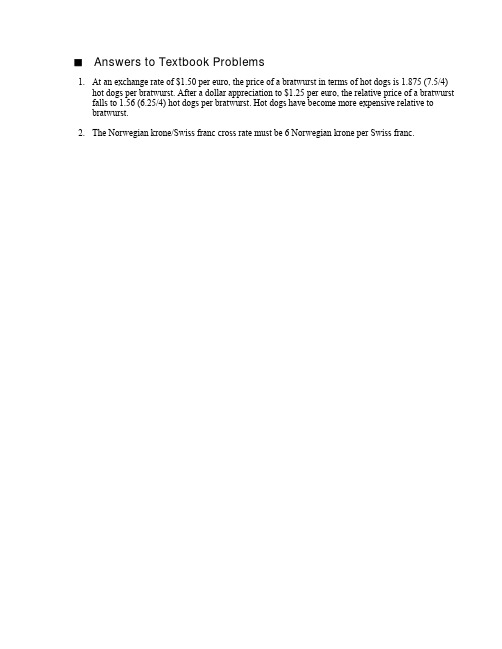
Answers to Textbook Problems1. At an exchange rate of $1.50 per euro, the price of a bratwurst in terms of hot dogs is 1.875 (7.5/4)hot dogs per bratwurst. After a dollar appreciation to $1.25 per euro, the relative price of a bratwurst falls to 1.56 (6.25/4) hot dogs per bratwurst. Hot dogs have become more expensive relative tobratwurst.2. The Norwegian krone/Swiss franc cross rate must be 6 Norwegian krone per Swiss franc.58 Krugman/Obstfeld •International Economics: Theory and Policy, Eighth Edition3. When the yen depreciates vs. the dollar, its costs go up. This depresses its profits. On the other hand,if it exports products to the U.S., it can increase the yen price (without changing the dollar price) so there may be some offsetting effects. But, by and large, a firm that has substantial imported input costs does not relish a depreciating home currency.4. The dollar rates of return are as follows:a. ($250,000 - $200,000)/$200,000 = 0.25.b. ($275 - $225)/$225 = 0.22.c. There are two parts to this return. One is the loss involved due to the appreciation of the dollar;the dollar appreciation is ($1.38 - $1.50)/$1.50 =-0.08. The other part of the return is theinterest paid by the London bank on the deposit, 10 percent. (The size of the deposit is immaterial to the calculation of the rate of return.) In terms of dollars, the realized return on the Londondeposit is thus 2 percent per year.5. Note here that the ordering of the returns of the three assets is the same whether we calculate real ornominal returns.a. The real return on the house would be 25% - 10% = 15%. This return could also be calculatedby first finding the portion of the $50,000 nominal increase in the house’s price due to inflation ($20,000), then finding the portion of the nominal increase due to real appreciation ($30,000),and finally finding the appropriate real rate of return ($30,000/$200,000 = 0.15).b. Again, subtracting the inflation rate from the nominal return, we get 20% - 10% = 10%.c. 2% - 10% =-8%.6. The current equilibrium exchange rate must equal its expected future level since, with equality ofnominal interest rates, there can be no expected increase or decrease in the dollar/pound exchange rate in equilibrium. If the expected exchange rate remains at $1.52 per pound and the pound interest rate rises to 10 percent, then interest parity is satisfied only if the current exchange rate changes such that there is an expected appreciation of the dollar equal to 5 percent. This will occur when theexchange rate rises to $1.60 per pound (a depreciation of the dollar against the pound).7. If market traders learn that the dollar interest rate will soon fall, they also revise upward theirexpectation of the dollar’s future depreciation in the foreign-exchange market. Given the current exchange rate and interest rates, there is thus a rise in the expected dollar return on euro deposits.The downward-sloping curve in the diagram below shifts to the right and there is an immediate dollar depreciation, as shown in the figure below where a shift in the interest-parity curve from II to I'I' leads to a depreciation of the dollar from E0 to E1.Figure 13.2Chapter 13 Exchange Rates and the Foreign-Exchange Market: An Asset Approach 59 8. The analysis will be parallel to that in the text. As shown in the accompanying diagrams, a movementdown the vertical axis in the new graph, however, is interpreted as a euro appreciation and dollar depreciation rather than the reverse. Also, the horizontal axis now measures the euro interest rate.Figure 13.3 demonstrates that, given the expected future exchange rate, a rise in the euro interest rate from R0 to R1 will lead to a euro appreciation from E0 to E1.Figure 13.4 shows that, given the euro interest rate of i, the expectation of a stronger euro in thefuture leads to a leftward shift of the downward-sloping curve from II to I'I' and a euro appreciation (dollar depreciation) from E to E'. A rise in the dollar interest rate causes the same curve to shiftrightward, so the euro depreciates against the dollar. This simply reverses the movement inFigure 13.4, with a shift from I'I' to II, and a depreciation of the euro from E' to E. All of theseresults are the same as in the text when using the diagram for the dollar rather than the euro.Figure 13.3 Figure 13.49. a. If the Federal Reserve pushed interest rates down, with an unchanged expected future exchangerate, t he dollar would depreciate (note that the article uses the term “downward pressure” to mean pressure for the dollar to depreciate). In terms of the analysis developed in this chapter, a moveby the Federal Reserve to lower interest rates would be reflected in a movement from R to R' inFigure 13.5, and a depreciation of the exchange rate from E to E*.If there is a “soft landing,” and the Federal Reserve does not lower interest rates, then this dollardepreciation will not occur. Even if the Federal Reserve does lower interest rates a little, say from R to R", this may be a smaller decrease then what people initially believed would occur. In thiscase, the expected future value of the exchange rate will be more appreciated than before,causing the interest-parity curve to shift in from II to I'I' (as shown in Figure 13.6). The shift inthe curve reflects the “optimism sparked by the expectation of a soft landing” and this change inexpectations means that, with a fall in interest rates from R to R", the exchange rate depreciatesfrom E to E", rather than from E to E*, which would occur in the absence of a change inexpectations.Figure 13.5 Figure 13.660 Krugman/Obstfeld •International Economics: Theory and Policy, Eighth Editionb. The “disruptive” effects of a recession make dollar holdings more risky. Risky assets must offersome extra compensation such that people willingly hold them as opposed to other, less riskyassets. This extra compensation may be in the form of a bigger expected appreciation of thecurrency in which the asset is held. Given the expected future value of the exchange rate, a bigger expected appreciation is obtained by a more depreciated exchange rate today. Thus, a recessionthat is disruptive and makes dollar assets more risky will cause a depreciation of the dollar.10. The euro is less risky for you. When the rest of your wealth falls, the euro tends to appreciate, cushioningyour losses by giving you a relatively high payoff in terms of dollars. Losses on your euro assets, on the other hand, tend to occur when they are least painful, that is, when the rest of your wealth is unexpectedly high. Holding the euro therefore reduces the variability of your total wealth.11. The chapter states that most foreign-exchange transactions between banks (which accounts for thevast majority of foreign-exchange transactions) involve exchanges of foreign currencies for U.S. dollars, even when the ultimate transaction involves the sale of one nondollar currency for another nondollar currency. This central role of the dollar makes it a vehicle currency in international transactions. The reason the dollar serves as a vehicle currency is that it is the most liquid of currencies since it is easy to find people willing to trade foreign currencies for dollars. The greater liquidity of the dollar ascompared to, say, the Mexican peso, means that people are more willing to hold the dollar than the peso, and thus, dollar deposits can offer a lower interest rate, for any expected rate of depreciation against a third currency, than peso deposits for the same rate of depreciation against that third currency.As the world capital market becomes increasingly integrated, the liquidity advantages of holdingdollar deposits as opposed to euro deposits will probably diminish. The euro represents an economy as large as the United States, so it is possible that it will assume some of that vehicle role of the dollar, reducing the liquidity advantages to as far as zero. When it was first introduced in 1999, the euro had no history as a currency, though, so some investors may have been leery of holding it until itestablished a track record. As the euro has become more established, though, the liquidity advantage of the dollar should be fading (albeit slowly).12. Greater fluctuations in the dollar interest rate lead directly to greater fluctuations in the exchange rateusing the model described here. The movements in the interest rate can be investigated by shifting the vertical interest rate curve. As shown in Figure 13.7, these movements lead directly to movements in the exchange rate. For example, an increase in the interest rate from i to i' leads to a dollar appreciation from E to E'. A decrease in the interest rate from i to i" leads to a dollar depreciation from E to E".This diagram demonstrates the direct link between interest rate volatility and exchange rate volatility, given that the expected future exchange rate does not change.Figure 13.7Chapter 13 Exchange Rates and the Foreign-Exchange Market: An Asset Approach 61 13. A tax on interest earnings and capital gains leaves the interest parity condition the same, since all itscomponents are multiplied by one less the tax rate to obtain after-tax returns. If capital gains areuntaxed, the expected depreciation term in the interest parity condition must be divided by 1 less the tax rate. The component of the foreign return due to capital gains is now valued more highly than interest payments because it is untaxed.14. The forward premium can be calculated as described in the appendix. In this case, we find theforward premium on euro to be (1.26 - 1.20)/1.20 = 0.05. The interest rate difference betweenone-year dollar deposits and one-year euro deposits will be 5 percent because the interest difference must equal the forward premium on euro against dollars when covered interest parity holds.15. The value should have gone down as there is no more need to engage in intra EU foreign currencytrading. This represents the predicted transaction cost savings stemming from the euro. At thesame time, the importance of the euro as an international currency may have generated more trading in euros as more investors (from central banks to individual investors) choose to hold their funds in euros or denominate transactions in euros. On net, though, we would expect the value of foreign exchange trading in euros to be less than the sum of the previous currencies.16. If the dollar depreciated, all else equal, we would expect outsourcing to diminish. If, as the problemstates, much of the outsourcing is an attempt to move production to locations that are relativelycheaper, then the U.S. becomes relatively cheap when the dollar depreciates. While it may not be as cheap a destination as some other locations, at the margin, labor costs in the U.S. will have become relatively cheaper, making some firms choose to retain production at home. For example, we could say that the labor costs of producing a computer in Malaysia is 220$ and the extra transport cost is 50$, but the U.S. costs were 300$, then we would expect the firm to outsource. On the other hand, if the dollar depreciated 20% against the Malaysian ringitt, the labor costs in Malaysia would now be 264$ (that is, 20% higher in dollar terms, but unchanged in local currency). This, plus the transport costs makes production in Malaysia more expensive than in the U.S., making outsourcing a lessattractive option.。
国际经济学习题与答案2

国际经济学习题与答案2第一章国际贸易理论的微观基础习题(一)选择题1.微观经济学研究的是单个社会的资源配置问题,而国际贸易理论研究的是()A 一国的资源配置问题B两国范围内的资源配置问题C地区范围内的资源配置问题D世界范围内的资源配置问题2. 一个人在作出选择时,()A如果边际收益非常大,他或她就不用考虑机会成本B进行最小机会成本的选择C比较该选择活动的边际成本和边际收益D只有当总利益非常大时,他或她才会选择使用其稀缺的资源3.机会成本()A由自己支付,而与他人无关B对劳务而言是零,因为劳务不会持续太久;对物品而言是正的,因为物品具有长久性C是为了进行某一选择而放弃的评价最高的选择D是为了进行某一选择放弃的所有选择4.如果两个人在商品的生产中具有不同的机会成本,那么他们能够从专业化与交换中()A都受损B一人受益,一人受损C既不受益,也不受损D都能够受益5. 沿着外凸的生产可能性边界线向下移动时,随着一种物品产量的增加,生产该物品的机会成本将()A保持不变B增加C减少D无法确定6 .一个国家(),能够在其生产可能性边界线之外的点上进行消费。
A没有任何时候B在充分就业的情况下C同其他国家进行贸易时D所有生产要素全部投入生产的时候7.供给曲线除了表示不同的价格水平所提供的商品数量外,还可以被认为是()A愿意并有能力支付的曲线B边际收益曲线C供给的最高价格曲线D供给的最低价格曲线8. 在封闭条件下,一国生产技术的改进降低了棉花的生产成本,那么棉花的价格(),棉花的生产数量()A上升;增加B上升;减少C下降;增加D下降;减少9 .对于两国贸易模型来说,国际均衡价格一定处于两国贸易前的()A最低相对价格水平之下B最高相对价格水平之上C相对价格水平之间D根据具体情况而定10 .经济学家作出这样的假设:作为一种目标,消费者总是在追求()A其效用最大化B其收入的最大化C其边际效用的最大化D以上选项均不对(二)简答题1如何理解狭义和广义的国际贸易,国际贸易理论的主要研究对象是什么?2既然国际贸易理论与微观经济学的基本原理存在着一致性,为什么还要区分国际贸易与国内贸易,将国际贸易作为一个独立的问题来研究呢?3用相对价格概念解释经济行为主体是如何摆脱“货币幻觉”的影响的。
冯德连主编《国际经济学》第二版课后习题答案
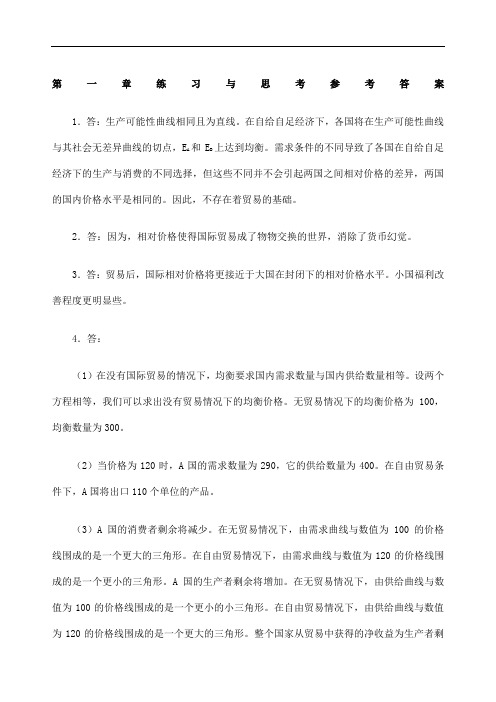
第一章练习与思考参考答案1.答:生产可能性曲线相同且为直线。
在自给自足经济下,各国将在生产可能性曲线与其社会无差异曲线的切点,EA 和EB上达到均衡。
需求条件的不同导致了各国在自给自足经济下的生产与消费的不同选择,但这些不同并不会引起两国之间相对价格的差异,两国的国内价格水平是相同的。
因此,不存在着贸易的基础。
2.答:因为,相对价格使得国际贸易成了物物交换的世界,消除了货币幻觉。
3.答:贸易后,国际相对价格将更接近于大国在封闭下的相对价格水平。
小国福利改善程度更明显些。
4.答:(1)在没有国际贸易的情况下,均衡要求国内需求数量与国内供给数量相等。
设两个方程相等,我们可以求出没有贸易情况下的均衡价格。
无贸易情况下的均衡价格为100,均衡数量为300。
(2)当价格为120时,A国的需求数量为290,它的供给数量为400。
在自由贸易条件下,A国将出口110个单位的产品。
(3)A国的消费者剩余将减少。
在无贸易情况下,由需求曲线与数值为100的价格线围成的是一个更大的三角形。
在自由贸易情况下,由需求曲线与数值为120的价格线围成的是一个更小的三角形。
A国的生产者剩余将增加。
在无贸易情况下,由供给曲线与数值为100的价格线围成的是一个更小的小三角形。
在自由贸易情况下,由供给曲线与数值为120的价格线围成的是一个更大的三角形。
整个国家从贸易中获得的净收益为生产者剩余的增加量与消费者剩余的减少量之差。
这一收益的大小等于一个三角形的面积:它的底边是产品贸易数量(110),它的高是价格的变化量(120-100=20)。
因此,总收益为1100。
5.答:他们的损失为,继续在国内销售480亿立方米木材价值的损失,加上少销售的40亿立方米木材价值总量的损失。
两者相加,共损失25亿美元。
6.答:(1)在自由贸易及每桶18美元价格下,国内生产数量QS 为18=+6QS,或QS=29亿桶。
国内消费数量18=42-4QD ,或QD=60亿桶。
国际经济学第八版下册答案
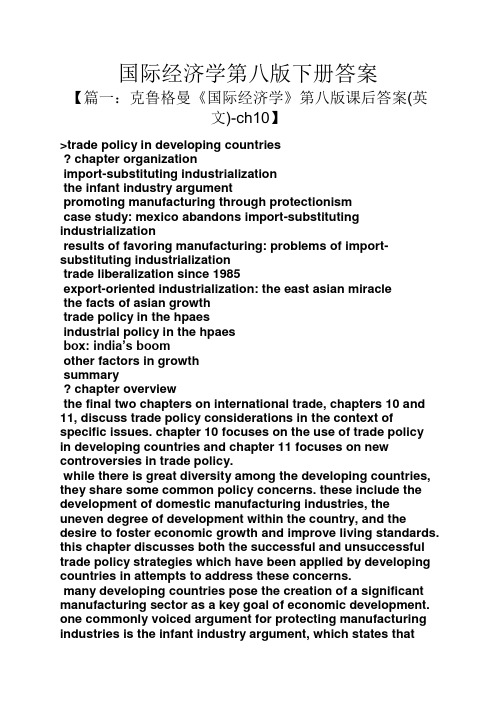
国际经济学第八版下册答案【篇一:克鲁格曼《国际经济学》第八版课后答案(英文)-ch10】>trade policy in developing countries? chapter organizationimport-substituting industrializationthe infant industry argumentpromoting manufacturing through protectionismcase study: mexico abandons import-substituting industrializationresults of favoring manufacturing: problems of import-substituting industrializationtrade liberalization since 1985export-oriented industrialization: the east asian miraclethe facts of asian growthtrade policy in the hpaesindustrial policy in the hpaesbox: india’s boomother factors in growthsummary? chapter overviewthe final two chapters on international trade, chapters 10 and 11, discuss trade policy considerations in the context of specific issues. chapter 10 focuses on the use of trade policyin developing countries and chapter 11 focuses on new controversies in trade policy.while there is great diversity among the developing countries, they share some common policy concerns. these include the development of domestic manufacturing industries, the uneven degree of development within the country, and the desire to foster economic growth and improve living standards. this chapter discusses both the successful and unsuccessful trade policy strategies which have been applied by developing countries in attempts to address these concerns.many developing countries pose the creation of a significant manufacturing sector as a key goal of economic development. one commonly voiced argument for protecting manufacturing industries is the infant industry argument, which states thatdeveloping countries have a potential comparative advantage inmanufacturing and can realize that potential through an initial period of protection. this argument assumes market failure in the form of imperfect capital markets or the existence of externalities in production. such a market failure makes the social return to production higher than the private return. this implies that a firm will not be able to recapture rents or profits that are in line with the contribution to welfare made by the product or industry establishment of the firm. without some government support, the argument goes, the amount of investment which will occur in this industry will be less than socially optimal levels.chapter 10 trade policy in developing countries 43given these arguments, many nations have attempted import-substitution-led industrialization. in the 1950s and 1960s the strategy was quite popular and did lead to a dramatic reduction in imports in some countries. the overall result, though, was not a success. the infant industry argument did not always hold, as protection could let young industries survive, but could not make them efficient. by the late 1980s, most countries had shifted away from the strategy, and the chapter includes a case study of mexico’s change from import substitution to a more open strategy.since 1985 many developing countries had abandoned import substitution and pursued (sometimesaggressively) trade liberalization. the chapter notes two sides of the experience. on the one hand, trade has gone up considerably and changed in character. developing countries export far more of the gdpthan prior to liberalization, and more of it is in manufacturing as opposed to agricultural or mining sectors. at the same time, the growth experience of these countries has not been universally good and it is difficult to tell if the success stories are due to trade or due to reforms that came at the same time as liberalization. the east asian “miracle” of the high-performing asian economies (hpaes) provides a striking andcontroversial example of export-oriented industrialization. while these countries encountered difficulties in the late 1990s (see chapter 22), this chapter focuses on their spectaculargrowth from the 1960s to 1990s. it is acknowledged that the growth was extremely impressive; the controversy is over the source of the success in these countries. some observers argue that although these countries do not practice free trade, they have lower rates of protection (and more outward orientation) than other developing countries. other observers argue that the interventionist industrial policies pursued by the hpaes have been the reason for success, and outward orientation is just a by-product of active rather than passive government involvement in industry. still others argue that high rates of domestic savings and rapid improvements in education are behind the stunning growth performance.? answers to textbook problems1. the countries that seem to benefit most from international trade include many of the countries of thepacific rim, south korea, taiwan, singapore, hong kong, malaysia, indonesia, and others. though the experience of each country is somewhat different, most of these countries employed some kind of infant industry protection during the beginning phases of their development, but then withdrew protection relatively quickly after industries became competitive on world markets. concerningwhether their experiences lend support to the infant industry argument or argues against it is still a matter of controversy. however, it appears that it would have been difficult for these countries to engage in export-led growth without some kind of initial government intervention.the japanese example gives pause to those who believe that protectionism is always disastrous.however, the fact of japanese success does not demonstrate that protectionist trade policy wasresponsible for that success. japan was an exceptional society that had emerged into the ranks of advanced nations before world war ii and was recovering from wartime devastation. it is arguable that economic success would have come anyway, so that the apparent success of protection represents a “pseudo-infant-industry” case of the kind discussed in the text.a. the initial high costs of production would justify infant industry protection if the costs to thesociety during the period of protection were less than the future stream of benefits from a mature, low cost industry.b. an individual firm does not have an incentive to bear development costs itself for an entireindustry when these benefits will accrue to other firms. thereis a stronger case for infantindustry protection in this instance because of the existenceof market failure in the form of theappropriability of technology. 2. 3.44 krugman/obstfeld ? international economics: theory and policy, eighth edition4. india ceased being a colony of britain in 1948, thus its dramatic break from all imports in favor ofmexico (as opposed to recently deposed colonial firms in india) may have helped keep mexico open to importing capital goods necessary in the manufacturing process.in some countries the infant industry argument simply did not appear to work well. such protection will not create a competitive manufacturing sector if there are basic reasonswhy a country does not have a competitive advantage in a particular area. this was particularly the case in manufacturing where many low-income countries lack skilled labor, entrepreneurs, and the level of managerialacumen necessary to be competitive in world markets. the argument is that trade policy alone cannot rectify these problems. often manufacturing was also created on such a small-scale that it made the industries noncompetitive, where economies of scale are critical to being a low-cost producer.moreover protectionist policies in less-developed countries have had a negative impact on incentives, which has led to “rent-seeking” or corruption.question 6 involves assessing the impact of dual labor markets. the topic is not covered extensively in the current edition of the book and instructors may not want to assign the question unless they bring additional material into the classroom to augment the text.a. we know that the wages should be equivalent, so, given that80 – la ? wa, we can substitute wm for wa, and recall that wm ? 100 – lm. combined with the information that la ? lm ? 100, we getl*a?40 and the equilibrium wage ? 40.b. since wm ? 50, lm ? 50 and thus la ? 50 and wm ? 30, we have a net loss of (0.5)(10)(20) ? 100 in national income. 5. 6.【篇二:国际经济学(克鲁格曼)课后习题答案1-8章】1.为什么说在决定生产和消费时,相对价格比绝对价格更重要?答案提示:当生产处于生产边界线上,资源则得到了充分利用,这时,要想增加某一产品的生产,必须降低另一产品的生产,也就是说,增加某一产品的生产是有机会机本(或社会成本)的。
国际经济学第三版课后练习题含答案
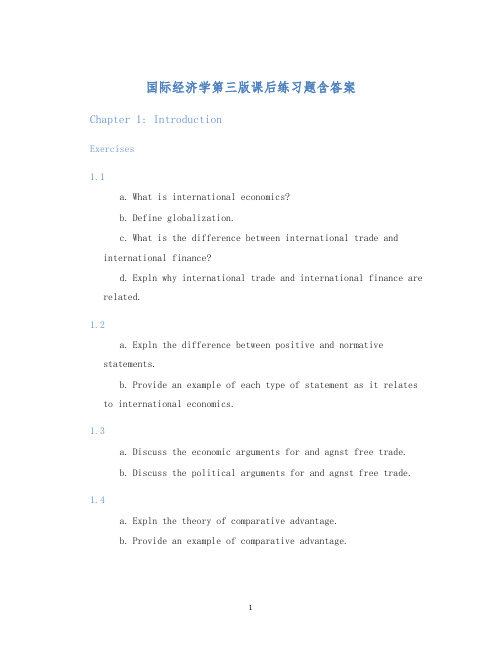
国际经济学第三版课后练习题含答案Chapter 1: IntroductionExercises1.1a.What is international economics?b.Define globalization.c.What is the difference between international trade andinternational finance?d.Expln why international trade and international finance arerelated.1.2a.Expln the difference between positive and normativestatements.b.Provide an example of each type of statement as it relatesto international economics.1.3a.Discuss the economic arguments for and agnst free trade.b.Discuss the political arguments for and agnst free trade.1.4a.Expln the theory of comparative advantage.b.Provide an example of comparative advantage.1.5a.Discuss the gns and losses from trade.b.Provide an example of the gns from trade.Answers1.1a.International economics is the study of how countriesinteract economically with each other and the consequences ofthose interactions.b.Globalization is the integration of economies and societiesacross the world through the exchange of goods, services, capital and people.c.International trade is the exchange of goods and servicesbetween countries. International finance refers to the movement of financial capital across borders, including foreign directinvestment, portfolio investment and international borrowing and lending.d.International trade and finance are related because tradenecessarily involves exchange of currencies, which in turn affects the demand and supply of currencies in international markets.1.2a.Positive statements are factual statements that can betested and verified or rejected based on evidence. Normativestatements are statements that express judgments or opinions about what ought to be.b.An example of a positive statement in international economics is。
international(国际经济学)课后习题及答案
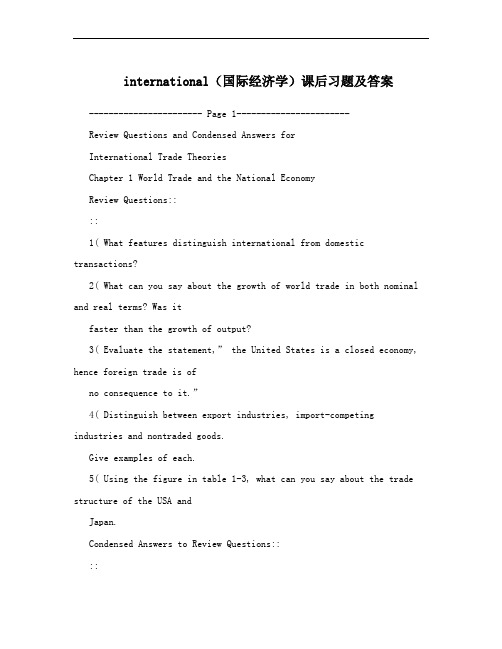
international(国际经济学)课后习题及答案----------------------- Page 1-----------------------Review Questions and Condensed Answers forInternational Trade TheoriesChapter 1 World Trade and the National EconomyReview Questions::::1( What features distinguish international from domestic transactions?2( What can you say about the growth of world trade in both nominal and real terms? Was itfaster than the growth of output?3( Evaluate the statement,” the United States is a closed economy, hence foreign trade is ofno consequence to it.”4( Distinguish between export industries, import-competing industries and nontraded goods.Give examples of each.5( Using the figure in table 1-3, what can you say about the trade structure of the USA andJapan.Condensed Answers to Review Questions::::1. The text discusses ways that international transactions differfrom domestic ones.i. International trade requires that transactions be conductedbetween twocurrencies mediated by an exchange rate. Domestic transactions are conductedin a single currency.ii. Commercial policies that operate to restrict international transactions cannot, ingeneral, be imposed on domestic trade. Such policies include tariffs, quotas,voluntary export restraints, export subsidies, and exchange controls.iii. Countries pursue different domestic macroeconomic policieswhich result indivergent rates of economic growth, inflation, and unemployment.iv. More statistical data exist on the nature, volume, and value of internationaltransactions than exist in domestic trade.v. Factors of production are more mobile domestically than internationally.vi. Countries exhibit different demand patterns, sales techniques,and marketingrequirements. Many of these are due to culture and custom. Someresult fromdifferences in government regulations. Included here are health, safety,environmental, and technical rules.2. The real volume of world exports grew at an annual rate of more than 6 percent between1950 and 2000. Global output grew at an annual rate of 4 percent. Export growth inexcess of output growth reflects the increased openness to trade of many countries.3. The United States is a relatively closed economy since the share of trade in GDP issmaller than that of most other industrial nations. In 2000, U.S. exports of goods andservices were 11 percent of GDP. The U.S. economy is less dependent on the foreignsector than other major economies, but to say that foreign trade is of no consequence is anexaggeration. The U.S. economy has become increasingly open and, therefore, moreimpacted by trade developments over time. This trend is likely to continue. Curtailingimports would, for example, have a big effect on consumers' ability to buy some goods----------------------- Page 2-----------------------(e.g. tropical products) and would raise the prices of others. The absence of certain keycommodities and material inputs would greatly disrupt areas of U.S. industry.4. a. Export industries send a substantial share of their output abroad. Ratios ofexports to GDP are much higher than the average ratio for all industries. Netexporting industries are those for which exports exceed imports. U.S. netexporting industries include farm products, chemicals, certain types of machinery,and aerospace products.b. Import-competing industries are domestic industries that sharethe domesticmarket with a substantial import presence. These activities haveratios ofimports to GDP that are much higher than the average ratio for all industries.U.S. import-competing industries include fuels, automobiles,clothing, footwear,and iron and steel.c. Nontraded goods are those which, because of their nature and characteristics, arenot easily exported or imported. Examples are hair-dressing, movie theaters,meals, construction activity, and health-care.5. Table 1.3 contains figures on the trade structure of the U.S. and Japan. The U.S. is a netexporter of food, certain ores, chemicals, and other machinery and transport equipment,and is a net importer of raw materials, mining products, fuels, nonferrous metals, iron andsteel, semimanufactures, office and telecommunications equipment, automotive products,textiles and clothing, and other consumer goods. Japan is a net exporter of iron and steel,chemicals, semimanufactures, office and telecommunications equipment, automotiveproducts, other machinery and transport equipment, and other consumer goods. Importsexceed exports in food, raw materials, and textiles and clothing.----------------------- Page 3-----------------------Chapter 2 Why Nations TradeReview Questions::::1( a. In what sense are the cost data of footnote 4 related to the figures of scheme 1?b. Based on the figures of footnote 4, determine the:Direction of trade once it develops.Limits to mutually beneficial trade.Limits to a sustainable exchange trade.2. Evaluate the following statements:a. In international trade, domestic cost ratios determine the limits of mutually beneficial trade,whereas demand considerations show where, within these limits, the actual exchange ratio will lie.b. Comparative advantage is a theoretical concept. It cannot be used to explain any real-worldphenomena.c. The opening up of trade raises the price of export goods; hence trade is inflationary.d. The concept of absolute advantage offers explainations for East Germany’s high unemploymentrates in the 1990s.3. a. Use the theory of comparative advantage to explain why it pays for:The USA to export grains and import oil.Russia to export oil and import grains.b. Why does the popular press believe that grain exports are inflnationary? What is wrongwith this porposition?Condensed Answers to Review Questions:1. a. Scheme 1 is based on labor productivity comparisons, while Footnote 4presentsper unit cost data. Production cost ratios are inversely related to productivitymeasures.b. i. Textiles will be exported from the U.K. and wheat from the U.S.ii. The U.S. will trade only if one yard of textiles costs less than3 bushels ofwheat. The U.K. will trade only if 1 yard of textiles can be exchangedfor more than 2 bushels of wheat.iii. The value of the ? must be between $1 and $1.502. a. Consider Figure 2.2. The domestic cost ratios define limits of mutually beneficialtrade. Within the region of mutually beneficial trade the actual exchange rate willbe determined by the relative intensity of each country's demand for the othercountry's product. A full analysis requires an understanding of reciprocal demandcurves, but the following general principle might help heuristically. If the Britishare more eager to buy U.S. wheat than the Americans are eager for British textiles,the exchange ratio falls close to the U.K. domestic cost ratio and the U.S. can beviewed as capturing a greater share of the gains from trade.b. Since the real world does not conform to the convenienttwo-country, two-goodassumptions, the simple theoretical model is not immediately applicable.However, we can generalize the model to many goods and many nations. Thefundamental truth remains. Countries export those goods in which their relativeproduction costs are lower and import those goods for which the relative costs arehigher.----------------------- Page 4-----------------------c. While trade tends to raise the prices of exportables in the domestic economy, theeffect of trade is to lower the average price level of all goods. Trade givesconsumers an opportunity to consume at lower world prices. Many goods will becheaper when purchased from foreign supply sources. Trade also conveysprocompetitive effects, stimulates the adoption of new technologies, and allowsfirms to achieve efficient scale production levels. Thus, trade is anti-inflationary.d. The reunification of the Germany economy in 1990 was undertaken on the basisthat a unit of the deutschmark, the West German currency, should be equal in valueto a unit of the ostmark, the East German currency. At this exchange rate, goodsproduced in East Germany were almost universally more expensive to producethan their counterparts in the West. Labor productivity in East Germanmanufacturing was found to be about 35% of the West German level. Underthese conditions the East German manufacturing sector collapsed. Investors werereluctant to purchase East German factories and large scale closures and dismissalsresulted.3. a. The U.S. enjoys a comparative advantage in grains. It also produces oil, but will gain byspecializing in grain production and using proceeds of exported agriculturalproducts to purchase oil from nations that produce oil relatively more efficiently.Russia is relatively more efficient in the production of oil and will gain bypurchasing grain from the U.S. in exchange for oil.b. The popular press asserts that by exporting grain from the U.S. (say to the former U R)we are lowering the domestic supply of grain and raising the domestic U.S. price of grain. Sincegrain is an important ingredient in many food products, grain exports are believed to increase theprice of those products. However, the price of grain is determined in world markets. U.S.exports alone cannot permanently raise the domestic U.S. price. If the domestic U.S. grainpricerose above the world price, the U.S. would be a net importer of grains and the domestic price wouldfall.----------------------- Page 5-----------------------Chapter 3 The Commodity Composition of TradeReview Questions::::1( Does the factor proportions theory provide a good explanation of intraindustry trade? Ifnot, can you outline an alternative explaination for the growing phenomenon?2( Explain the dynamic nature of comparative advantage using Japan’s experience as anexample.3( Once the United States acquires a comparative advantage in jet aircraft production it canbe sure of a dominant position in the global market forever. Do you agree with thisstatement? Explain.Condensed Answers to Review Questions1. The factor proportions theory is better suited to explain interindustry trade, or the exchangebetween countries of totally different commodities, than intraindustry trade, which is thetwo-way trade of similar commodities. The growth of intraindustry trade is greatest inimperfectly competitive industries characterized by economies of scale. Here, scaleeconomies force firms in each industry to specialize in a narrow range of products withineach industry to achieve efficient scale operations. Intraindustry specialization combinedwith diverse consumer tastes gives rise to two-way trade within the same industryclassification.2. Japan's comparative advantage in the immediate post-war period was in labor intensivegoods. The high level of saving and investment transformed Japan into a relatively capitalabundant country. Its advantage in the labor-intensive industries was lost as wages rose.Moreover, Japan increased its technological capability through high spending on R&D.Now Japan's advantage lies in the production of high-tech, capital intensive goods similar tothe U.S. This in large part explains the increasing trade friction between the twocountries.3. Once the U.S. acquires a comparative advantage in jet aircraft, it is likely to enjoy a dominantposition in the global marketplace for years, but not forever. Jet aircraft production is characterizedby huge economies of scale due largely to research and development costs. High capitalrequirements and scale economies pose large entry barriers. It is extremely difficult for a countryto enter into aircraft production once the U.S. has the lead. The new firm would initially have asmall market share and would be unable to compete on a cost basis. The new market entrant wouldrequire considerable government support and encouragement. This was the case with the EuropeanAirbus.----------------------- Page 6-----------------------Chapter 4 Protection of Domestic Industries: The TariffReview Questions::::1( A tariff on textiles is equivalent to a tax on consumers and a subsidy to the textileproducers and workers.2( Explain the concept of effective rate of protection.a. What does the effective rate on final goods depend upon and how?b. In what way does the effective rate analysis help to illuminate these policy issues:Deepening of production in LDCsEscalation of tariff rates by degree of processing in industrial countries3. A tariff lowers the real income of the country, while at the same time it distributes income fromconsumers to the governments and to the import-competing industry.Condensed Answers to Review Questions:1. The effect of a tariff is comparable to the combined effects of a tax on consumers and a subsidy toproducers. Using Figure 4.3, one can show a tariff results in a transfer of resources from theconsumers (who lose P P fd ) to the producers (who gain P P ec). With a non-prohibitive tariff, the2 3 2 3government will also gain revenue efmn. Whether the two schemes are equivalent depends on theexact nature of the tax and subsidy scheme.2. a. The effective rate of protection measures the percentage increase in domesticvalue added per unit of output made possible by tariffs on the output and onmaterial inputs. Determinants of the effective rate include thetariff on the finalproduct, tariffs on the imported material inputs, and the free trade value added perunit of output which is influenced by intermediate input coefficients. Effectiverates are positively related to the tariff on the final product and negatively related toboth tariffs on imported inputs and the free trade value added. A derivation ofthe formula appears in footnote 10, and footnote 12 interprets that formula.b. "Deepening" of production in LDCs involves import substitution industrializationpolicy. A final assembly plant is given a protective tariff and imported inputs areaccorded duty free treatment. As a second stage, the LDC begins to deepenproduction by manufacturing inputs and according them protection. By imposingtariffs on imported inputs, the LDC is reducing effective protection for the finalgood.Because of relatively high rates of protection on finished goods and low protectionon unfinished goods and raw materials, effective tariff rates in developed countriesmay be as much as double their nominal counterparts. Developing countriesmaintain that such tariff structures fatally harm their efforts to increase exports offinished manufactures.3. Again using Figure4.3, the loss in real income is shown by triangles cen and mfd.Redistribution has been given in 8a.----------------------- Page 7-----------------------Chapter 5 Nontariff Barriers (NTBs) to TradeReview Question::::Suppose the USA steel industry is seeking protection from foreign imports. Compare andcontrast the following measures of restricting steel industries: a tariff, a quota, and voluntaryexport restraints.Condensed Answers to Review Question:There are a variety of ways in which a tariff may be considered to be less harmful than an equivalentquota:i. The revenue effect. Tariffs provide revenue. Quotas do not automatically providerevenue. Under a quota, revenue accrues to holders of import licenses.Depending on the quota scheme, licenses may be held by domestic importers, foreign exporters, foreign governments, or domestic officialswho may use them to encourage bribery. Only through auctioning or selling licenses can the government capture quota rents.ii. Performance under demand and supply changes. Any amount of imports can enterunder a tariff, but with a quota import volumes are fixed. When demandgrows, or there is a shortfall in supply, the quota does not permit a quantityadjustment. The domestic price can depart significantly from the worldprice. Under a tariff, the domestic price cannot rise above the worldprice by more than the tariff rate. Thus, a tariff is less harmful than aquota.iii. Impact on Exporters. When a tariff is levied on an imported good it is usually rebatedwhen the good is exported. The same is not true for a quota. Quotas maytherefore be more harmful to export performance.iv. Curbing monopoly power. Quotas curtail monopoly power less than an equivalent tariff.v. Terms of Trade Effects. Quotas provide no incentive for exporting nations to absorb partof the price increase; tariffs do if the exporting nation wishes to retainmarket share.vi. Quality Upgrading. Quotas give an incentive for the exporting country to engage in qualityupgrading. Ad valorem tariffs do not provide an incentive for this behavior but specific duties do.VERs share all of the undesirable effects of quotas. When the exporter does the restricting, there isno opportunity to sell import licenses. Quota rents accrue toforeign exporters orgovernments under a VER. Therefore, VERs are more costly to society than anequivalent quota with licenses sold or a tariff. Quantitative restrictions like VERsare discriminatory. VERs are also hard to monitor. Since shipments from thirdparty countries are unrestricted, transshipment throughnonrestricted countries is amajor problem. One advantage of VERs is they do not invite retaliation sincethey are profitable to foreign exporters and governments.Tariffs, quotas and VERs may be equivalent in terms of effects on the domestic price and thevolumeof imports. This may be shown using diagram 5-1. However, there are important differencesdiscussed in 1a. above.----------------------- Page 8-----------------------Chapter 6 International and Regional Trade Organizations Among Developed CountriesReview Questions::::1. Explain the following terms:Trade creation of a customs union.Trade diversion of a customs union.2.What are the conflicts between the WTO and the environmental movement?Condensed Answers to Review Questions:1. Trade creation refers to the replacement of high cost production in each member by importsfrom another member. This effect is favorable to world welfare. Tradediversion is the diversion of trade from a nonmember to a higher cost member.This is unfavorable because it reduces worldwide resource allocative efficiency(See Figure 4-8).The basic approach to calculating welfare effects associated with customs union formation is toconstruct hypothetical estimates of what member country trade patterns wouldhave been in the absence of integration, comparing these with actual trade flows,and attributing any difference to integration. Effects ofintegration can be isolatedby using trade flow data pertaining to nonmember "normalizer" countries over thesame period to suggest what trade patterns would have been expected for memberswithout integration. Assume, in the absence of integration, both total (internalplus external) and external member imports would have grown at the same rates asthe corresponding imports in the normalizer. The normalizer's external importsrefer to its imports from third countries (i.e. intra-trade is excluded). Thenormalizer's internal imports are imports of normalizer countries from each other(e.g. intra-trade). The preintegration member country total import level ismultiplied by the corresponding normalizer import growth rate to yield an estimateof hypothetical total imports without integration. When compared with actualtotal imports, an estimate of trade creation is obtained. Trade diversion isestimated by multiplying the member country preintegration external import levelby the normalizer's rate of change of external imports to yield hypothetical membercountry external imports. The excess of hypothetical over actual external importsconstitutes trade diversion. The European Union (EU) is a customs unioncomprised of 15 West European countries.2. WTO rules often conflict with both international environmental agreements and nationalenvironmental laws. For example, a 1991 GATT panel upheld a Mexican challenge to aU.S. law banning importation of tuna caught indolphin-killing purse-seine nets.GATT/WTO provisions are concerned with products and not production methods.----------------------- Page 9-----------------------Chapter 7 International Mobility of Productive FactorsReview Question::::What is the meaning of DFI? List some of the factors that induce companies to invest abroad.Condensed Answers to Review Question:Direct Foreign Investment refers to international capital movement that gives a company controlover a foreign subsidiary. It may be the purchase of an existing company, a substantial part of itsshares, or the establishment of a new enterprise. It should be contrasted with portfolio investmentthat gives, by and large, no control over foreign assets.The motives are diverse and any particular investment may involve one or more of the followingi. investment in extractive industries to secure raw material supplies;ii. investment in manufacturing industry to take advantage of cheaper foreign labor;iii. to locate production close to foreign markets and avoid transportation costs;iv. to take advantage of incentives offered by host countries;v. to circumvent tariff barriers;vi. changes in the exchange values of currencies; andvii. marketing considerations.。
克鲁格曼《国际经济学》(第8版)课后习题详解
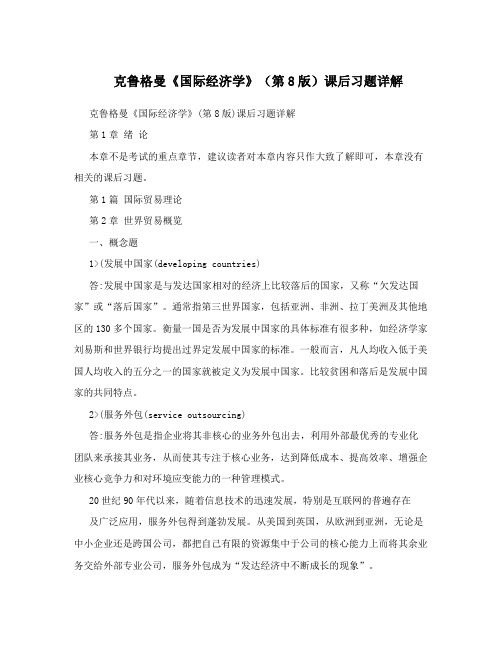
克鲁格曼《国际经济学》(第8版)课后习题详解克鲁格曼《国际经济学》(第8版)课后习题详解第1章绪论本章不是考试的重点章节,建议读者对本章内容只作大致了解即可,本章没有相关的课后习题。
第1篇国际贸易理论第2章世界贸易概览一、概念题1>(发展中国家(developing countries)答:发展中国家是与发达国家相对的经济上比较落后的国家,又称“欠发达国家”或“落后国家”。
通常指第三世界国家,包括亚洲、非洲、拉丁美洲及其他地区的130多个国家。
衡量一国是否为发展中国家的具体标准有很多种,如经济学家刘易斯和世界银行均提出过界定发展中国家的标准。
一般而言,凡人均收入低于美国人均收入的五分之一的国家就被定义为发展中国家。
比较贫困和落后是发展中国家的共同特点。
2>(服务外包(service outsourcing)答:服务外包是指企业将其非核心的业务外包出去,利用外部最优秀的专业化团队来承接其业务,从而使其专注于核心业务,达到降低成本、提高效率、增强企业核心竞争力和对环境应变能力的一种管理模式。
20世纪90年代以来,随着信息技术的迅速发展,特别是互联网的普遍存在及广泛应用,服务外包得到蓬勃发展。
从美国到英国,从欧洲到亚洲,无论是中小企业还是跨国公司,都把自己有限的资源集中于公司的核心能力上而将其余业务交给外部专业公司,服务外包成为“发达经济中不断成长的现象”。
3>(引力模型(gravity model)答:丁伯根和波伊赫能的引力模型基本表达式为:其中,是国与国的贸易额,为常量,是国的国内生产总值,是国的国内生产总值,是两国的距离。
、、三个参数是用来拟合实际的经济数据。
引力模型方程式表明:其他条件不变的情况下,两国间的贸易规模与两国的GDP成正比,与两国间的距离成反比。
把整个世界贸易看成整体,可利用引力模型来预测任意两国之间的贸易规模。
另外,引力模型也可以用来明确国际贸易中的异常现象。
4>(第三世界(third world)答:第三世界这个名词原本是指法国大革命中的Third Estate(第三阶级)。
克鲁格曼《国际经济学》(第8版)课后习题详解

克鲁格曼《国际经济学》(第8版)课后习题详解克鲁格曼《国际经济学》(第8版)课后习题详解第1章绪论本章不是考试的重点章节,建议读者对本章内容只作大致了解即可,本章没有相关的课后习题。
第1篇国际贸易理论第2章世界贸易概览一、概念题1>(发展中国家(developing countries)答:发展中国家是与发达国家相对的经济上比较落后的国家,又称“欠发达国家”或“落后国家”。
通常指第三世界国家,包括亚洲、非洲、拉丁美洲及其他地区的130多个国家。
衡量一国是否为发展中国家的具体标准有很多种,如经济学家刘易斯和世界银行均提出过界定发展中国家的标准。
一般而言,凡人均收入低于美国人均收入的五分之一的国家就被定义为发展中国家。
比较贫困和落后是发展中国家的共同特点。
2>(服务外包(service outsourcing)答:服务外包是指企业将其非核心的业务外包出去,利用外部最优秀的专业化团队来承接其业务,从而使其专注于核心业务,达到降低成本、提高效率、增强企业核心竞争力和对环境应变能力的一种管理模式。
20世纪90年代以来,随着信息技术的迅速发展,特别是互联网的普遍存在及广泛应用,服务外包得到蓬勃发展。
从美国到英国,从欧洲到亚洲,无论是中小企业还是跨国公司,都把自己有限的资源集中于公司的核心能力上而将其余业务交给外部专业公司,服务外包成为“发达经济中不断成长的现象”。
3>(引力模型(gravity model)答:丁伯根和波伊赫能的引力模型基本表达式为:其中,是国与国的贸易额,为常量,是国的国内生产总值,是国的国内生产总值,是两国的距离。
、、三个参数是用来拟合实际的经济数据。
引力模型方程式表明:其他条件不变的情况下,两国间的贸易规模与两国的GDP成正比,与两国间的距离成反比。
把整个世界贸易看成整体,可利用引力模型来预测任意两国之间的贸易规模。
另外,引力模型也可以用来明确国际贸易中的异常现象。
4>(第三世界(third world)答:第三世界这个名词原本是指法国大革命中的Third Estate(第三阶级)。
(完整版)国际经济学课后答案
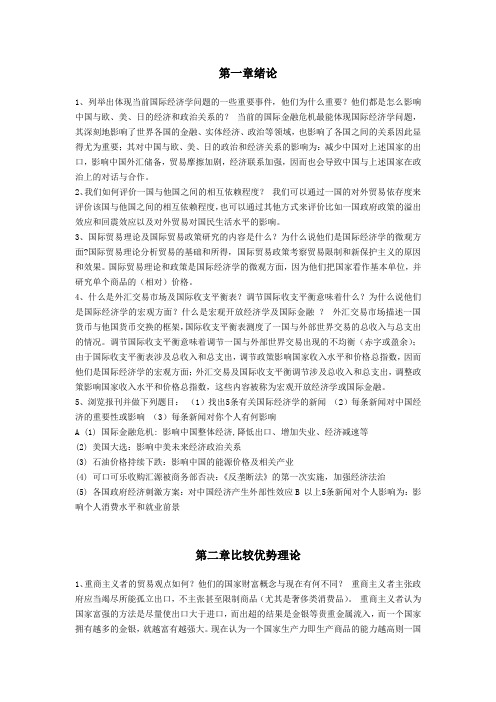
第一章绪论1、列举出体现当前国际经济学问题的一些重要事件,他们为什么重要?他们都是怎么影响中国与欧、美、日的经济和政治关系的?当前的国际金融危机最能体现国际经济学问题,其深刻地影响了世界各国的金融、实体经济、政治等领域,也影响了各国之间的关系因此显得尤为重要;其对中国与欧、美、日的政治和经济关系的影响为:减少中国对上述国家的出口,影响中国外汇储备,贸易摩擦加剧,经济联系加强,因而也会导致中国与上述国家在政治上的对话与合作。
2、我们如何评价一国与他国之间的相互依赖程度?我们可以通过一国的对外贸易依存度来评价该国与他国之间的相互依赖程度,也可以通过其他方式来评价比如一国政府政策的溢出效应和回震效应以及对外贸易对国民生活水平的影响。
3、国际贸易理论及国际贸易政策研究的内容是什么?为什么说他们是国际经济学的微观方面?国际贸易理论分析贸易的基础和所得,国际贸易政策考察贸易限制和新保护主义的原因和效果。
国际贸易理论和政策是国际经济学的微观方面,因为他们把国家看作基本单位,并研究单个商品的(相对)价格。
4、什么是外汇交易市场及国际收支平衡表?调节国际收支平衡意味着什么?为什么说他们是国际经济学的宏观方面?什么是宏观开放经济学及国际金融?外汇交易市场描述一国货币与他国货币交换的框架,国际收支平衡表测度了一国与外部世界交易的总收入与总支出的情况。
调节国际收支平衡意味着调节一国与外部世界交易出现的不均衡(赤字或盈余);由于国际收支平衡表涉及总收入和总支出,调节政策影响国家收入水平和价格总指数,因而他们是国际经济学的宏观方面;外汇交易及国际收支平衡调节涉及总收入和总支出,调整政策影响国家收入水平和价格总指数,这些内容被称为宏观开放经济学或国际金融。
5、浏览报刊并做下列题目:(1)找出5条有关国际经济学的新闻(2)每条新闻对中国经济的重要性或影响(3)每条新闻对你个人有何影响A (1) 国际金融危机: 影响中国整体经济,降低出口、增加失业、经济减速等(2) 美国大选:影响中美未来经济政治关系(3) 石油价格持续下跌:影响中国的能源价格及相关产业(4) 可口可乐收购汇源被商务部否决:《反垄断法》的第一次实施,加强经济法治(5) 各国政府经济刺激方案:对中国经济产生外部性效应B 以上5条新闻对个人影响为:影响个人消费水平和就业前景第二章比较优势理论1、重商主义者的贸易观点如何?他们的国家财富概念与现在有何不同?重商主义者主张政府应当竭尽所能孤立出口,不主张甚至限制商品(尤其是奢侈类消费品)。
《国际经济学》课后习题参考答案
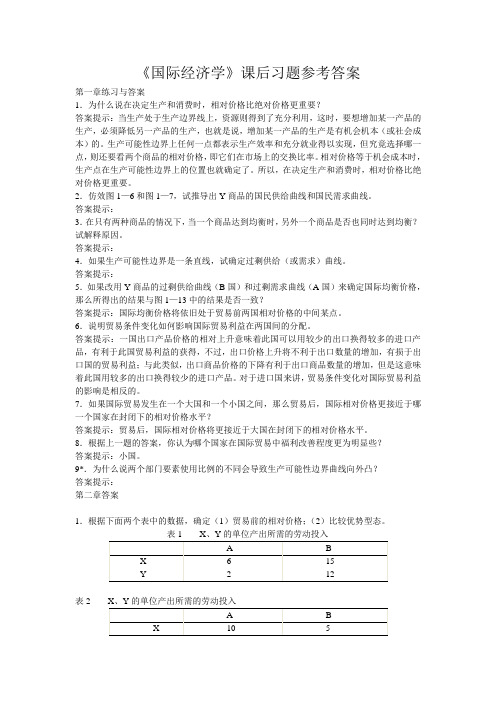
《国际经济学》课后习题参考答案第一章练习与答案1.为什么说在决定生产和消费时,相对价格比绝对价格更重要?答案提示:当生产处于生产边界线上,资源则得到了充分利用,这时,要想增加某一产品的生产,必须降低另一产品的生产,也就是说,增加某一产品的生产是有机会机本(或社会成本)的。
生产可能性边界上任何一点都表示生产效率和充分就业得以实现,但究竟选择哪一点,则还要看两个商品的相对价格,即它们在市场上的交换比率。
相对价格等于机会成本时,生产点在生产可能性边界上的位置也就确定了。
所以,在决定生产和消费时,相对价格比绝对价格更重要。
2.仿效图1—6和图1—7,试推导出Y商品的国民供给曲线和国民需求曲线。
答案提示:3.在只有两种商品的情况下,当一个商品达到均衡时,另外一个商品是否也同时达到均衡?试解释原因。
答案提示:4.如果生产可能性边界是一条直线,试确定过剩供给(或需求)曲线。
答案提示:5.如果改用Y商品的过剩供给曲线(B国)和过剩需求曲线(A国)来确定国际均衡价格,那么所得出的结果与图1—13中的结果是否一致?答案提示:国际均衡价格将依旧处于贸易前两国相对价格的中间某点。
6.说明贸易条件变化如何影响国际贸易利益在两国间的分配。
答案提示:一国出口产品价格的相对上升意味着此国可以用较少的出口换得较多的进口产品,有利于此国贸易利益的获得,不过,出口价格上升将不利于出口数量的增加,有损于出口国的贸易利益;与此类似,出口商品价格的下降有利于出口商品数量的增加,但是这意味着此国用较多的出口换得较少的进口产品。
对于进口国来讲,贸易条件变化对国际贸易利益的影响是相反的。
7.如果国际贸易发生在一个大国和一个小国之间,那么贸易后,国际相对价格更接近于哪一个国家在封闭下的相对价格水平?答案提示:贸易后,国际相对价格将更接近于大国在封闭下的相对价格水平。
8.根据上一题的答案,你认为哪个国家在国际贸易中福利改善程度更为明显些?答案提示:小国。
冯德连主编-人民大学出版社《国际经济学》第二版课后习题答案

冯德连主编-人民大学出版社《国际经济学》第二版课后习题答案内消费数量18=42-4Q D ,或Q D =60亿桶。
见下图。
(2)在无进口时,国内供给数量必须在国内均衡价格P 处等于国内需求数量(两者都等于Q E ):42-4Q E =0.6+6Q E ,或Q E =41.4亿桶(生产和消费的数量)。
利用其中一个等式,我们可以计算出,国内价格为每桶25.44美元。
(3)国内石油生产者将获益。
他们得到了以图中面积a 代表的生产者剩余。
国内石油消费者将受到损失,即由图中面积a+b+c 代表的消费者剩余。
7.答:一个没有贸易的假想世界有5个条件:(1)两国相同商品的生产函数相同;(2)O 数量(10亿桶) 18 D S P O 25.44 a b D S 数量(10亿桶)c 18 2.9 6.0 2.9 6.0 4.14两国的相对要素禀赋相同;(3)两国的消费偏好相同;(4)规模收益不变;(5)两国的商品市场和要素市场都是完全竞争市场。
如果5个条件同时成立,那么,两国在封闭条件下的相对价格完全相同,因此,在这些条件下国际贸易是不可能发生的。
第二章练习与思考参考答案1.答:(1)2000045=+YX。
(2)封闭条件下,此国生产可能性边界的斜率是-5/4=PX /PY。
因为X的国际相对价格为2,所以此国出口X进口Y。
出口1000个单位的X 可以换得2000个单位的Y。
贸易三角形即可划出。
2.答:古典学派认为国际贸易发生的原因在于生产成本上的差异,古典学派假设劳动是惟一的生产要素,因而,古典学派的生产函数一般形式可写成如下形式:Q=F(L)因生产函数规模收益不变,故根据规模收益不变的定义,对任意的常数λ>0,则有:F(λL)= λF(L)由于λ可任意取值,不妨令λ=1/L,则:F(1)=(1/L)F(L)上式左边是一常数,它表示单位劳动投入的产出,而右边则表示平均劳动产出,即平均劳动生产率。
由等式可知,平均劳动生产率是固定不变的。
《国际经济学》第二版课后章节参考答案
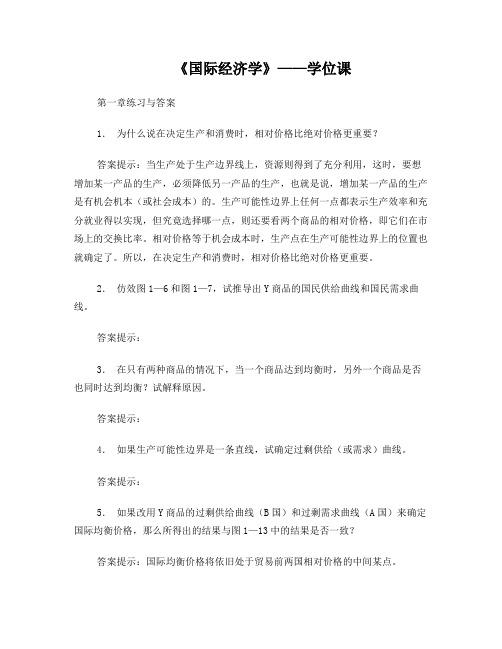
《国际经济学》——学位课第一章练习与答案1.为什么说在决定生产和消费时,相对价格比绝对价格更重要?答案提示:当生产处于生产边界线上,资源则得到了充分利用,这时,要想增加某一产品的生产,必须降低另一产品的生产,也就是说,增加某一产品的生产是有机会机本(或社会成本)的。
生产可能性边界上任何一点都表示生产效率和充分就业得以实现,但究竟选择哪一点,则还要看两个商品的相对价格,即它们在市场上的交换比率。
相对价格等于机会成本时,生产点在生产可能性边界上的位置也就确定了。
所以,在决定生产和消费时,相对价格比绝对价格更重要。
2.仿效图1—6和图1—7,试推导出Y商品的国民供给曲线和国民需求曲线。
答案提示:3.在只有两种商品的情况下,当一个商品达到均衡时,另外一个商品是否也同时达到均衡?试解释原因。
答案提示:4.如果生产可能性边界是一条直线,试确定过剩供给(或需求)曲线。
答案提示:5.如果改用Y商品的过剩供给曲线(B国)和过剩需求曲线(A国)来确定国际均衡价格,那么所得出的结果与图1—13中的结果是否一致?答案提示:国际均衡价格将依旧处于贸易前两国相对价格的中间某点。
6.说明贸易条件变化如何影响国际贸易利益在两国间的分配。
答案提示:一国出口产品价格的相对上升意味着此国可以用较少的出口换得较多的进口产品,有利于此国贸易利益的获得,不过,出口价格上升将不利于出口数量的增加,有损于出口国的贸易利益;与此类似,出口商品价格的下降有利于出口商品数量的增加,但是这意味着此国用较多的出口换得较少的进口产品。
对于进口国来讲,贸易条件变化对国际贸易利益的影响是相反的。
7.如果国际贸易发生在一个大国和一个小国之间,那么贸易后,国际相对价格更接近于哪一个国家在封闭下的相对价格水平?答案提示:贸易后,国际相对价格将更接近于大国在封闭下的相对价格水平。
8.根据上一题的答案,你认为哪个国家在国际贸易中福利改善程度更为明显些?答案提示:小国。
国际经济学课后练习题答案(下册)

04
全球化与发展经济学
全球化对经济的影响
全球化对经济增长的影响
全球化对技术进步的影响
全球化促进了国际贸易和资本流动, 推动了世界经济的增长。
全球化使得企业可以引进国外先进技 术和管理经验,促进本国的技术进步。
全球化对就业的影响
全球化使得企业可以在全球范围内寻 找成本更低的劳动力,从而影响本国 的就业市场。
05
国际经济政策与合作
关税与非关税壁垒
总结词
关税与非关税壁垒是国际经济政策中的 重要手段,对国际贸易产生深远影响。
VS
详细描述
关税是政府对进口商品征收的税费,旨在 保护国内产业和市场。然而,过高的关税 可能导致贸易伙伴采取报复措施,引发贸 易战。非关税壁垒包括技术标准、卫生检 疫、知识产权保护等措施,这些措施可能 对进口商品构成隐性限制,影响国际贸易 自由化。
• 详细描述:跨国公司经营策略的主要内容包括市场拓展、资源配置、技术创新 和组织管理等,旨在实现全球范围内的资源优化配置和市场竞争优势。跨国公 司对于推动全球化进程、促进国际贸易和经济增长具有重要作用。
• 总结词:跨国公司经营策略的制定需要考虑多方面因素,包括目标市场、竞争 环境、企业资源和组织能力等。
比较优势理论
• 总结词:比较优势理论认为一个国家应该专注于生产并出口其机会成本 较低的产品,同时进口其机会成本较高的产品。
• 详细描述:比较优势理论是由英国经济学家大卫·李嘉图提出的,他认为 即使一个国家在生产所有产品上都不具有绝对优势,但如果它在生产某 种产品上的机会成本低于其他国家,那么它仍然可以选择生产这种产品 并出口。
详细描述
市场寻求是指企业为了扩大市场份额 、获取更多消费者而进行的投资;资 源寻求是指企业为了获得稳定的原材 料供应而进行的投资;效率寻求是指 企业为了降低生产成本、提高管理效 率而进行的投资;技术寻求是指企业 为了获取先进技术、提高产品竞争力 而进行的投资。
国际经济学课后习题及答案(2)

第一章国际贸易理论的微观基础1.为什么说在决定生产和消费时,相对价格比绝对价格更重要?答案提示:当生产处于生产边界线上,资源则得到了充分利用,这时,要想增加某一产品的生产,必须降低另一产品的生产,也就是说,增加某一产品的生产是有机会机本(或社会成本)的。
生产可能性边界上任何一点都表示生产效率和充分就业得以实现,但究竟选择哪一点,则还要看两个商品的相对价格,即它们在市场上的交换比率。
相对价格等于机会成本时,生产点在生产可能性边界上的位置也就确定了。
所以,在决定生产和消费时,相对价格比绝对价格更重要。
2.仿效图1—6和图1—7,试推导出Y商品的国民供给曲线和国民需求曲线。
答案提示:参照教材中第一章第二节(第26页)的内容,将图1-6(a)中,以横坐标表示Y商品的供给,以纵坐标表示X商品供给,得出相应的生产可能性曲线;然后将图1-6(b)中,以横坐标表示Y商品的供给,以纵坐标表示Y的相对价格P Y/P X,通过类似推导可得出国民供给曲线,国民需求曲线做类似推导即可求出。
3.在只有两种商品的情况下,当一个商品达到均衡时,另外一个商品是否也同时达到均衡?试解释原因。
答案提示:两种商品同时达到均衡。
当一种商品达到均衡时,该商品的相对价格、均衡供给与需求、均衡状态下对生产要素的需求与供给都得以确定,则可得到另一种商品的相对价格、生产要素需求,从而确定该商品的均衡状态下供给和需求。
4.如果生产可能性边界是一条直线,试确定过剩供给(或需求)曲线。
答案提示:参照教材图1-12、图1-13国民供给曲线与国民需求曲线的推导;过剩供给(或需求)曲线的形状,参见教材第30页。
5.如果改用Y商品的过剩供给曲线(B国)和过剩需求曲线(A国)来确定国际均衡价格,那么所得出的结果与图1—13中的结果是否一致?答案提示:相一致。
国际均衡价格将依旧处于贸易前两国相对价格的中间某点。
6.说明贸易条件变化如何影响国际贸易利益在两国间的分配。
(完整版)国际经济学第十版课后答案(萨尔瓦多、杨冰译)
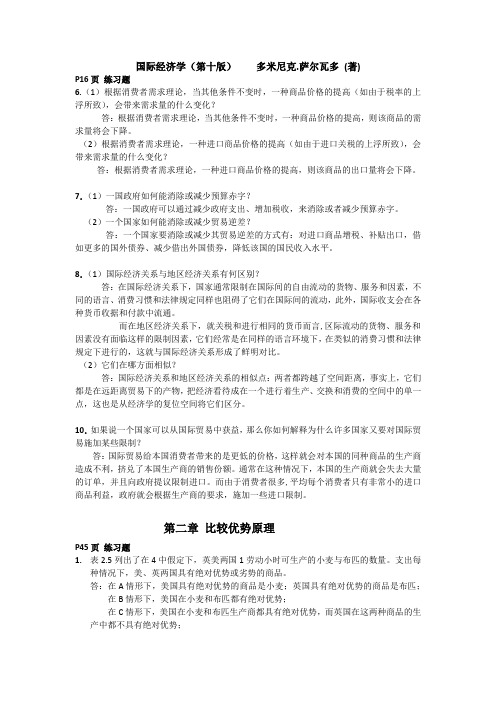
国际经济学(第十版)多米尼克.萨尔瓦多(著)P16页练习题6.(1)根据消费者需求理论,当其他条件不变时,一种商品价格的提高(如由于税率的上浮所致),会带来需求量的什么变化?答:根据消费者需求理论,当其他条件不变时,一种商品价格的提高,则该商品的需求量将会下降。
(2)根据消费者需求理论,一种进口商品价格的提高(如由于进口关税的上浮所致),会带来需求量的什么变化?答:根据消费者需求理论,一种进口商品价格的提高,则该商品的出口量将会下降。
7.(1)一国政府如何能消除或减少预算赤字?答:一国政府可以通过减少政府支出、增加税收,来消除或者减少预算赤字。
(2)一个国家如何能消除或减少贸易逆差?答:一个国家要消除或减少其贸易逆差的方式有:对进口商品增税、补贴出口,借如更多的国外债券、减少借出外国债券,降低该国的国民收入水平。
8.(1)国际经济关系与地区经济关系有何区别?答:在国际经济关系下,国家通常限制在国际间的自由流动的货物、服务和因素,不同的语言、消费习惯和法律规定同样也阻碍了它们在国际间的流动,此外,国际收支会在各种货币收据和付款中流通。
而在地区经济关系下,就关税和进行相同的货币而言,区际流动的货物、服务和因素没有面临这样的限制因素,它们经常是在同样的语言环境下,在类似的消费习惯和法律规定下进行的,这就与国际经济关系形成了鲜明对比。
(2)它们在哪方面相似?答:国际经济关系和地区经济关系的相似点:两者都跨越了空间距离,事实上,它们都是在远距离贸易下的产物,把经济看待成在一个进行着生产、交换和消费的空间中的单一点,这也是从经济学的复位空间将它们区分。
10.如果说一个国家可以从国际贸易中获益,那么你如何解释为什么许多国家又要对国际贸易施加某些限制?答:国际贸易给本国消费者带来的是更低的价格,这样就会对本国的同种商品的生产商造成不利,挤兑了本国生产商的销售份额。
通常在这种情况下,本国的生产商就会失去大量的订单,并且向政府提议限制进口。
国际经济学(下册国际金融)克鲁格曼 中文答案
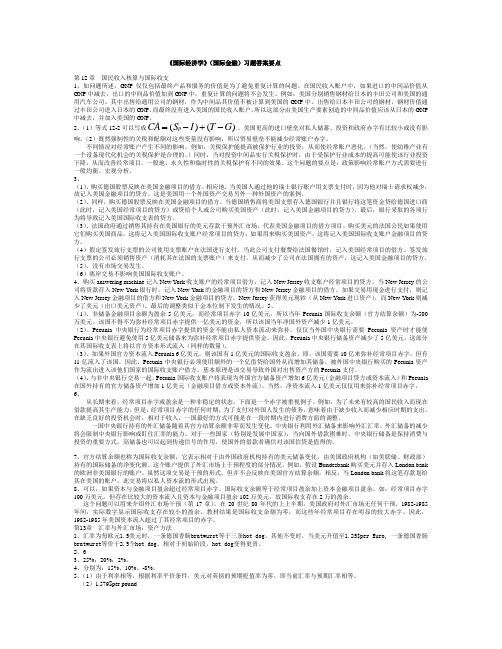
《国际经济学》(国际金融)习题答案要点第12章 国民收入核算与国际收支1、如问题所述,GNP 仅仅包括最终产品和服务的价值是为了避免重复计算的问题。
在国民收入账户中,如果进口的中间品价值从GNP 中减去,出口的中间品价值加到GNP 中,重复计算的问题将不会发生。
例如:美国分别销售钢材给日本的丰田公司和美国的通用汽车公司。
其中出售给通用公司的钢材,作为中间品其价值不被计算到美国的GNP 中。
出售给日本丰田公司的钢材,钢材价值通过丰田公司进入日本的GNP ,而最终没有进入美国的国民收入账户。
所以这部分由美国生产要素创造的中间品价值应该从日本的GNP 中减去,并加入美国的GNP 。
2、(1)等式12-2可以写成()()p CA S I T G =-+-。
美国更高的进口壁垒对私人储蓄、投资和政府赤字有比较小或没有影响。
(2)既然强制性的关税和配额对这些变量没有影响,所以贸易壁垒不能减少经常账户赤字。
不同情况对经常账户产生不同的影响。
例如,关税保护能提高被保护行业的投资,从而使经常账户恶化。
(当然,使幼稚产业有一个设备现代化机会的关税保护是合理的。
)同时,当对投资中间品实行关税保护时,由于受保护行业成本的提高可能使该行业投资下降,从而改善经常项目。
一般地,永久性和临时性的关税保护有不同的效果。
这个问题的要点是:政策影响经常账户方式需要进行一般均衡、宏观分析。
3、(1)、购买德国股票反映在美国金融项目的借方。
相应地,当美国人通过他的瑞士银行账户用支票支付时,因为他对瑞士请求权减少,故记入美国金融项目的贷方。
这是美国用一个外国资产交易另外一种外国资产的案例。
(2)、同样,购买德国股票反映在美国金融项目的借方。
当德国销售商将美国支票存入德国银行并且银行将这笔资金贷给德国进口商(此时,记入美国经常项目的贷方)或贷给个人或公司购买美国资产(此时,记入美国金融项目的贷方)。
最后,银行采取的各项行为将导致记入美国国际收支表的贷方。
《国际经济学》课后习题答案
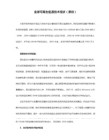
第一章1.为什么说在决定生产和消费时,相对价格比绝对价格更重要?答案提示:当生产处于生产边界线上,资源则得到了充分利用,这时,要想增加某一产品的生产,必须降低另一产品的生产,也就是说,增加某一产品的生产是有机会机本(或社会成本)的。
生产可能性边界上任何一点都表示生产效率和充分就业得以实现,但究竟选择哪一点,则还要看两个商品的相对价格,即它们在市场上的交换比率。
相对价格等于机会成本时,生产点在生产可能性边界上的位置也就确定了。
所以,在决定生产和消费时,相对价格比绝对价格更重要2.仿效图1—6和图1—7,试推导出Y商品的国民供给曲线和国民需求曲线。
答:参见教材第一章第二节内容,将图1-6a中,以横坐标表示y商品的供给,以纵坐标表示x商品供给,得出相应生产可能性边界线,然后将图1-6b中,以横坐标表示y商品供给,以纵坐标表示y的相对价格,通过类似推导可得出国民供给曲线,国民需求曲线作类似推导可得。
3.在只有两种商品的情况下,当一个商品达到均衡时,另外一个商品是否也同时达到均衡?答:两种商品同时达到均衡。
一种商品均衡时,由其相对价格,机会成本,需求可知另一种商品得相对价格,机会成本和需求。
4.如果生产可能性边界是一条直线,试确定过剩供给(或需求)曲线。
答案提示:略,参见书上5.如果改用Y商品的过剩供给曲线(B国)和过剩需求曲线(A国)来确定国际均衡价格,那么所得出的结果与图1—13中的结果是否一致?答案提示:国际均衡价格将依旧处于贸易前两国相对价格的中间某点。
6.说明贸易条件变化如何影响国际贸易利益在两国间的分配。
答案提示:一国出口产品价格的相对上升意味着此国可以用较少的出口换得较多的进口产品,有利于此国贸易利益的获得,不过,出口价格上升将不利于出口数量的增加,有损于出口国的贸易利益;与此类似,出口商品价格的下降有利于出口商品数量的增加,但是这意味着此国用较多的出口换得较少的进口产品。
对于进口国来讲,贸易条件变化对国际贸易利益的影响是相反的。
国际经济学第八版下册课后答案英文版17

Answers to Textbook Problems1. An expansion of the central bank’s domestic assets leads to an equal fall in its foreign assets, withno change in the bank’s liabilities (or the money supply). The effect on the balance-of-paymentsaccounts is most easily understood by recalling how the fall in foreign reserves comes about. After the central bank buys domestic assets with money, there is initially an excess supply of money. The central bank must intervene in the foreign exchange market to hold the exchange rate fixed in the face of this excess supply: the bank sells foreign assets and buys money until the excess supply of money has been eliminated. Since private residents acquire the reserves the central bank loses, there is a non-central bank capital outflow (a financial-account debit) equal to the increase in foreign assets held by the private sector. The offsetting credit is the reduction in central bank holdings of foreign assets, an official financial inflow.2. An increase in government spending raises income and also money demand. The central bank preventsthe initial excess money demand from appreciating the domestic currency by purchasing foreign assets from the domestic public. Central bank foreign assets rise, as do the central bank’s liabilit ies and, with them, the money supply. The central bank’s additional reserve holdings show up as anofficial capital outflow, a capital-account debit. Offsetting this debit is the capital inflow(a credit) associated with the public’s equal reduction in it s own foreign assets.3. A one-time unexpected devaluation initially increases output; the output increase, in turn, raisesmoney demand. The central bank must accommodate the higher money demand by buying foreign assets with domestic currency, a step th at raises the central bank’s liabilities (and the home money supply) at the same time as it increases the bank’s foreign assets. The increase in official foreign reserves is an official capital outflow; it is matched in the balance of payments accounts by the equal capital outflow associated with the public’s own reduction in net foreign asset holdings. (The public must exchange foreign assets for the money it buys from the central bank, either by selling foreign assets or by borrowing foreign currency abroad. Either course of action is a capital inflow.)A more subtle issue is the following: when the price of foreign currency is raised, the value of theinitial stock of foreign reserves rises when measured in terms of domestic currency. This capital gain in itself raises central-bank foreign assets (which were measured in domestic currency units in our analysis)—so where is the corresponding increase in liabilities? Does the central bank inject more currency or bank-system reserves into the economy to balance its balance sheet? The answer is that central banks generally create fictional accounting liabilities to offset the effect of exchange-rate fluctuations on the home-currency value of international reserves. These capital gains and losses do not automatically lead to changes in the monetary base.4. As shown in Figure 17.1, a devaluation causes the AA curve to shift to A'A' which reflects anexpansion in both output and the money supply in the economy. Figure 17.1 also contains an XXcurve along which the current account is in balance. The initial equilibrium, at point 0, was on the XX curve, reflecting the fact that the current account was in balance there. After the devaluation,the new equilibrium point is above and to the left of the XX curve, in the region where the current account is in surplus. With fixed prices, a devaluation improves an economy’s competitiveness,increasing its exports, decreasing its imports, and raising the level of output.Chapter 17 Fixed Exchange Rates and Foreign-Exchange Intervention 85Figure 17.15. a. Germany clearly had the ability to change the dollar/DM exchange simply by altering its moneysupply. The fact that “billions of dollars worth of currencies are traded each day” is irrelevantbecause exchange rates equilibrate markets for stocks of assets, and the trade volumes mentioned are flows.b. One must distinguish between sterilized and nonsterilized intervention. The evidenceregarding sterilized intervention suggests that its effects are limited to the signaling aspect.This aspect may well be most important when markets are “unusually erratic,” and the signalscommunicated may be most credible when the central bank is not attempting to resist clear-cutmarket trends (which depend on the complete range of government macroeconomic policies,among other factors). Nonsterilized intervention, however, is a powerful instrument in affectingexchange rates.c. The “psychological effect” of a “stated intention” to intervene may be more precisely stated as aneffect on the expected future level of the exchange rate.d. A rewrite might go as follows:To keep the dollar from falling against the West German mark, the European central banks would have to sell marks and buy dollars, a procedure known as intervention.86 Krugman/Obstfeld •International Economics: Theory and Policy, Eighth EditionBecause the available stocks of dollar and mark bonds are so large, it is unlikely that sterilizedintervention in the dollar/mark market, even if carried out by the two most economicallyinfluential members of the European Community—Britain and West Germany—would havemuch effect. The reason is that sterilized intervention changes only relative bond supplies andleaves national money supplies unchanged. Intervention by the United States and Germany thatwas not sterilized, however, would affect those countries’ money supplies and have a significant impact on the dollar/mark rate.Economists believe that the direct influence of sterilized intervention on exchange rates issmall compared with that of nonsterilized intervention. Even sterilized intervention can affectexchange rates, however, through its indirect influence on market expectations about futurepolicies. Such psychological effects, which can result from just the stated intention of theCommunity’s central banks to intervene, can disrupt the market by confusing traders aboutofficial plans. The signaling effect of intervention is most likely to benefit the authorities whentheir other macroeconomic policies are already being adjusted to push the exchange rate in thedesired direction.6. The problems caused by exchange-rate variability are discussed at length in Chapter 19; somemonetary policy autonomy might willingly be sacrificed to reduce these problems. Policy-makers might also sacrifice autonomy to enter into cooperative arrangements with foreign policy-makers that reduce the risk of “beggar-thy-neighbor” policy actions (see the appendix to Chapter 19).7. By raising output, fiscal expansion raises imports and thus worsens the current-account balance.The immediate fall in the current account is smaller than under floating, however, because thecurrency does not appreciate and crowd out net exports.8. The reason that the effects of temporary and permanent fiscal expansions differ under floatingexchange rates is that a temporary policy has no effect on the expected exchange rate while apermanent policy does. The AA curve shifts with a change in the expected exchange rate. In terms of the diagram, a permanent fiscal expansion causes the AA curve to shift down and to the leftwhich, combined with the outward shift in the DD curve, results in no change in output. With fixed exchange rates, however, there is no change in the expected exchange rate with either policy since the exchange rate is, by definition, fixed. In response to both temporary and permanent fiscal expansions, the central bank must expand the money supply (shift AA out) to prevent the currency fromappreciating (due to the shift out in the DD curve). Thus, Y goes up and E does not changeafter a permanent or temporary fiscal expansion when exchange rates are fixed.9. By expanding output, a devaluation automatically raises private saving, since part of any increase inoutput is saved. Government tax receipts rise with output, so the budget deficit is likely to decline, implying an increase in public saving. We have assumed investment to be constant in the main text. If investment instead depends negatively on the real interest rate (as in the IS-LM model), investment rises because devaluation raises inflationary expectations and thus lowers the real interest rate.(The nominal interest rate remains unchanged at the world level.) The interest-sensitive components of consumption spending also rise, and if these interest rate effects are strong enough, a current-account deficit could result.Chapter 17 Fixed Exchange Rates and Foreign-Exchange Intervention 87 10. An import tariff raises the price of imports to domestic consumers and shifts consumption fromimports to domestically produced goods. This causes an outward shift in the DD curve, increasing output and appreciating the currency. Since the central bank cannot allow exchange rates to change, it must increase the money supply, an action depicted in the diagram as an outward shift in the AAschedule. Corresponding to this monetary expansion is a balance of payments surplus and an equal increase in official foreign reserves.The fall in imports for one country implies a fall in exports for another country, and a corresponding inward shift of that country’s DD curve necessitating a monetary contraction by the central bank to preserve its fixed exchange rate. If all countries impose import tariffs, then no country succeeds in turning world demand in its favor or in gaining reserves through an improvement in its balance of payments. Trade volumes shrink, however, and all countries lose some of the gains from trade.11. If the market expects the devaluation to “stick,” the home nominal interest rate falls to the world levelafterward, money demand rises, and the central bank buys foreign assets with domestic money to prevent excess money demand from appreciating the currency. The central bank thus gains official reserves, according to our model. Even if another devaluation was to occur in the near future,reserves might be gained if the first devaluation lowered the depreciation expected for the future and, with it, the home nominal interest rate. An inadequate initial devaluation could, however, increase the devaluation expected for the future, with opposite effects on the balance of payments.12. If the Bank of Japan holds U.S. dollars instead of Treasury bills, the adjustment process is symmetric.Any purchase of dollars by the Bank of Japan leads to a fall in the U.S. money supplyas the dollar bills go out of circulation and into the Bank of Japan’s vaults. A Japanese balance of payments surplus increases the Bank of Japan’s money supply (if there is no sterilizati on) andreduces the U.S. money supply at the same time.13. A central bank that is maintaining a fixed exchange rate will require an adequate buffer stock offoreign assets on hand during periods of persistent balance of payments deficits. If a central bank depletes its stock of foreign reserves, it is no longer able to keep its exchange rate from depreciating in response to pressures arising from a balance of payments deficit. Simply put, a central bank can either choose the exchange rate and allow its reserve holdings to change or choose the amount of foreign reserves it holds and allow the exchange rate to float. If it loses the ability to control theamount of reserves because the private demand for them exceeds its supply, it can no longer control the exchange rate. Thus, a central bank maintaining a fixed exchange rate is not indifferent about using domestic or foreign assets to implement monetary policy.14. An ESF intervention to support the yen involves an exchange of dollar-denominated assets initiallyowned by the ESF for yen-denominated assets initially owned by the private sector. Since this is an exchange of one type of bond for another, there is no change in the money supply and thusthis transaction is automatically sterilized. This transaction increases the outstanding stock ofdollar-denominated assets held by the private sector, which increases the risk premium on dollar-denominated assets.88 Krugman/Obstfeld •International Economics: Theory and Policy, Eighth Edition15. The monetary authorities can combine a change in the money supply with a purchase or sale of itsforeign assets to keep the exchange rate fixed while altering the domestic interest rate. For example, the monetary authorities lower domestic interest rates by increasing the money supply. To maintain a fixed value of the exchange rate, the monetary authority would also sell foreign assets and purchase domestic assets. In the Figure 17.2, the increase in the money supply lowers the interest rate from R0 to R'. The purchase of domestic assets and sale of foreign assets, while having no further effect on the money supply, lowers the risk premium, shifts the interest parity schedule from II to I'I' and maintains the exchange rate at E0.Figure 17.216.Assets LiabilitiesFA: 900 Deposits held by banks: 400DA: 1500 Currency: 2000The central bank’s foreign assets still drop, and consequently liabilities must still drop also. In this case, though, currency has not changed, but after the check clears, the issuing bank has $100 less held as a deposit at the central bank.17. Yes, there is some room within a target zone for domestic interest rates to move independently ofthe foreign rate. For a one-year rate, we might see that when R* rises 1%, the home currencydepreciates 1%, setting an expected appreciation of the home currency back to the middle of the band, thus offsetting the 1% lower interest rate. On a shorter maturity, one could—in theory—expect achange in the exchange rate of up to 2% (top to bottom of the band) in three months. This allowsthree-month rates to be 2% apart, meaning annualized rates could be over 8% apart. The shorter the maturity, the difference becomes essentially unbounded. But, this would require that the fixedexchange rate remains credible. On a ten-year bond, there can be only a 0.2% difference in rates as expected appreciation could be a maximum of 0.2% a year for the ten years.18. In a three country world, a central bank fixes one exchange rate but lets the other float. It is stillconstrained in its ability to use monetary policy. It must manipulate the money supply to keep the interest rate at the level that maintains interest parity. It has no autonomy. At the same time, it cannot keep more than one exchange rate fixed.Chapter 17 Fixed Exchange Rates and Foreign-Exchange Intervention 89 19. Consider an example where France sells domestic assets (DA) for gold. If other central banks wantto hold onto their monetary gold, they will raise interest rates (by selling domestic assets to reduce the money supply) to keep gold from leaving their country. The consequence may be that all central banks reduce their DA holdings and still hold the same amount of gold. Put differently, if France tries to sell domestic assets for gold and all other central banks do the same thing, the net effect is that there is still the same amount of gold on the asset side of all central banks balance sheets combined, but the domestic assets have gone down. Thus, the total assets have declined and there has been a monetary contraction. In contrast, if France buys U.S. dollar assets to hold as reserves in a reserves currency system, they can buy the dollars on the open market in exchange for domestic assets. If the investors want to hold dollars and the price of dollars begins to rise, the Fed can easily increase the supply of dollars by purchasing foreign assets in exchange for dollars. Thus, both have increased their foreign reserves, and there was no need for the assets side of the balance sheet to decline.20. When a country devalues against the reserve currency, the value of its reserves in foreign currency isunchanged, but the local currency value is now different. A devaluation, where the foreign currency can now buy more local currency leads to an increase in the value of reserves measured in localcurrency. If a country revalues, this will lead to local currency losses. These potential valuationgains and losses will affect the costs of reserves. A country receiving a lower interest rate on U.S.treasury bills than it pays on its own debt is experiencing a cost of holding reserves, but if uncovered interest parity holds, this interest rate gap loss should be exactly offset by exchange rate changes and valuation gains as the local currency is expected to depreciate versus the dollar (because local R is R U.S.). On the other hand, countries with large stocks of dollar reserves expose themselves to losses if the dollar depreciates rapidly. As long as U.S. interest rates are greater than local rates(which if the dollar is expected to depreciate, they should be), these losses will be offset by interest rate gains. On the other hand, if there are unexpected changes in the exchange rate, then we will see the valuation gains or losses materialize without any offsetting interest rate payments. In some sense, one cost of holding large stocks of reserves is exposure to these unexpected changes.。
- 1、下载文档前请自行甄别文档内容的完整性,平台不提供额外的编辑、内容补充、找答案等附加服务。
- 2、"仅部分预览"的文档,不可在线预览部分如存在完整性等问题,可反馈申请退款(可完整预览的文档不适用该条件!)。
- 3、如文档侵犯您的权益,请联系客服反馈,我们会尽快为您处理(人工客服工作时间:9:00-18:30)。
课后习题第3题
a. 美国人购买德国的股票应记入美国金融项目的借 方。相应的,当美国人从瑞士银行账户开出支票 来支付款项时,需记入美国金融项目的贷方。因 为这个时候美国人在瑞士银行账户里面的余额减 少了,相当于卖出资产。 b. 美国人购买德国的股票应记入美国金融项目的借 方。而美国人支付给德国的卖出人这张美国支票, 同样也会发生贷记项目。德国银行会将这笔钱带 给德国的进口商(记入美国经常项目的贷方)或 者购买美国资产的个人和公司(记入美国景经常 项目的贷方)。最终德国银行会采取行动,使这 笔钱记入美国国际收支账户的贷方。
借方(进口了产品),对于新泽西州而言,要记 入经常项目的贷方(出口了产品)。 当新泽西公司将所得的支票存入纽约州的银行时, 那么记入纽约州金融项目的贷方(资本流入), 记入新泽西州金融项目的借方(资本流出)。 当纽约人用现金支付,这笔交易应记入新泽西州 金融项目的借方(获得美元,相当于进口资产), 记入纽约州金融项目的贷方(出口美元,相当于 出口资产)。
Copyright © 2003 Pearson Education, Inc.
Copyright © 2003 Pearson Education, Inc.
Chapter 14 第2题
一国人口下降会导致货币总需求减少。在其他条
件相同的情况下,人口下降会导致交易货币需求 下降。 家庭数目减少引起人口下降对货币总需求的影响 比家庭平均规模下降的影响更大。因为家庭平均 规模下降暗含小孩人口的减少,而小孩相对于大 人而言交易性货币需求较少,因此由于人口减少 并没有对收入造成一定影响,实际货币总需求变 化不大。而家庭数目减少会导致实际货币需求比 较明显的下降。
Copyright © 2003 Pearson Education, Inc.
课后练习题第6题
一国实际货币需求的永久性变化在长期将影响名
义汇率,但不影响实际汇率。在任何利率水平下, 随着实际货币需求的永久性增加,长期名义汇率 会同比例升值,相反,实际货币需求永久性减少, 长期名义汇率将同比例贬值。 长期实际汇率是取决于商品的相对价格和相对劳 动生产率变动,不会受一般价格水平的影响。
Copyright © 2003 Pearson Education, Inc.
E. 没有发生市场交易,无需记入经常项目或金融
项目。 F. 这种离岸交易不会记入美国的国际收支账户。
Copyright © 2003 Pearson Education, Inc.
课后练习题第4题
电话录音机的购买对于纽约州应记入经常项目的
Copyright © 2003 Pearson Education, Inc.
课后练习题第5题
英国实际有效汇率的变化过程是:1977-1981年英
镑升值,接着1981-1984年是连续贬值。1979年油 价上升,英镑升值最快。1982年油价上升减缓后, 英镑贬值最为严重。 油价上升增加了英国石油出口商的收入,增加了 英国的商品需求。劳动力供给转移到石油部门。 这也导致了实际汇率的上升。相反,油价下跌有 相反的效应。
Copyright © 2003 Pearson Education, Inc.
课后练习题第13题
国际间预期实际利率方面的差异会对实际汇率的
变动产生影响。如果美国预测实际利率是9%,欧 洲预测实际利率是3%,那么可以推断美元/欧元的 实际汇率将贬值6%(假设利率平价条件成立)。
Copyright © 2003 Pearson Education, Inc.
Chapter 12第2题
Sp = I + CA – Sg = I + CA – (T – G) = I + CA + (G – T) CA= Sp –I+ (T – G) CA=EX-IM (12-2)
美国设立较高的进口壁垒,对于美国的私人储蓄,国内投 资和政府财政赤字不会有直接的影响。 进口限制对于经常项目的影响是不确定的。 一方面,受到进口限制保护的行业的投资会增加,从而会 使I增加,从而使经常项目恶化,赤字增加。 另一方面,由于进口限制,会导致行业原材料进口成本的 增加,从而使该行业的投资减少,从而改善了经常项目赤 字。 因此,进口限制对经常项目的影响是不确定的。
Copyright © 2003 Pearson Education, Inc.
Chapter 15 第2题
分析实际汇率升值的原因。如果实际汇率的升值是由 于非贸易品相对于贸易品需求增加,对非贸易品需求 的增加会使非贸易品价格水平上升,导致全国总价格 水平上涨,实际汇率升值,这种情况对于出口商是不 利的,因为实际汇率升值使该国的产品相对于贸易国 而言昂贵了,不利于该国的出口部门。 如果实际汇率的升值是由于对本国贸易品相对需求的 增加所导致的,对该国贸易品需求的增加会使该国贸 易品价格上涨,导致实际价格总水平上升,实际汇率 升值。另外,贸易品部门劳动生产率的提高会导致实 际汇率升值,而这个实际汇率的升值对出口部门是有 利的。
Copyright © 2003 Pearson Education, Inc.
课后练习题第4题
a. b. c.
投资该画的收益率是(25-20)/20 x 100%=25% 此种葡萄酒的收益率是(216-180)/180 x 100%=20% 该种国外存款的收益包括两个部分: 一部分是由于美元升值或英镑相对贬值带来的损失。 英镑相对贬值率是(1.38-1.5)/1.5 x 100%=-8% 另一部分是收益,则是伦敦银行对这笔存款支付的 10%的利息。 因此,在伦敦银行存款的年收益率是-8%+10%=2%
Copyright © 2003 Pearson Education, Inc.
第2题(2)
如果增加关税是永久性政策,在长期会导致本币
升值,AA曲线下移,由AA变为AA’,均衡点一 到2,本币名义汇率再度升值,产出水平恢复到最 初充分就业水平。从长期看,总产出水平不会发 生变化。
Copyright © 2003 Pearson Education, Inc.
Copyright © 2003 Pearson Education, Inc.
课后练习题第2题
7.5 挪威克朗=1美元=1.25瑞士法郎 因此,1瑞士法郎=7.5/1.25=6挪威克朗。 汇率为6挪威克朗/瑞士法郎
Copyright © 2003 Pearson Education, Inc.
Copyright © 2003 Pearson Education, Inc.
课后练习题第3题
当非贸易品的价格相对于贸易品价格上升时,非
贸易品支出的增加会导致实际汇率升值。 外国转向对本国出口产品的需求,会导致对本国 商品的过度需求,进而提高这些商品的相对价格, 并促使本国的实际汇率上升。
值的预期,则Ee将变大,从而使欧元存款的美元 预期收益率增加。导致曲线I移到I’,美元对欧元 贬值,汇率从E 升高到E
0 1.
Copyright © 2003 Pearson Education, Inc.
Copyright © 2003 Pearson Education, Inc.
Chapter 14 第1题
Copyright © 2003 Pearson Education, Inc.
Chapter 13 第1题
当汇率为每欧元1.5美元,以热狗衡量的多
味腊肠的价格是 (5x1.5)/4=1.875 个热狗。 当其他条件相同,美元升值为每欧元1.25美 元,以热狗衡量的多味腊肠的价格是 (5x1.25)/4=1.625个热狗,相对价格下降了。 此时,热狗相对于多味腊肠而言变贵了。
Copyright © 2003 Pearson Education, Inc.
C.法国政府买进法国货币,而卖出了美元。卖出
的美元需要记入美国的金融项目的借方。而购买 美元的法国居民可能用美元来购买美国商品,那 么此时就记入经常项目的贷方;可能用于购买美 国的资产,此时就记入金融项目的贷方。 D.假定发行旅行支票的公司用其在法国的支票账 户进行支付。旅行支票公司支付旅行者在法国餐 厅的费用时,所付款项(服务)记入美国的经常 项目。如果使用旅行支票的公司需要卖出资产 (减少在法国支票账户余额)来支付款项,那么 这笔法国资产的减少就将记入美国金融项目的贷 方。
Chapter 16 第1题
投资需求的下降会降低任何汇率水平下的总需求
量,则导致DD曲线向左移动。
Copyright © 2003 Pearson Education, Inc.
课后练习题第2题(1)
如果增加关税是暂时性的财政政策,则消
费会转移到国内产品,国内产品总需求增 加,DD曲线向右移,而AA曲线短期内是不 变的。最终导致产出增加,本币的名义汇 率下降,本币升值。
Copyright © 2003 Pearson Education, Inc.
第5题
a. 实际收益率=25%-10%=15% b. 实际收益率=20%-10%=10% c. 实际收益率=2%-10%=-8%
Copyright © 2003 Pearson Education, Inc.
实际货币需求减少与名义货币供应增加具有相同
的效应。实际货币总需求下降,即实际货币需求 曲线向左移,从L1移到L2。 短期影响:如果是暂时性的实际货币需求减少, 则会影响利率的降低,导致本币贬值,最终均衡 汇率是E2 长期影响:长期来看,价格是非粘性的,随着实 际货币需求量的减少,价格水平同比例上升,导 致实际货币供应量减少,从M/P1到M/P2,利率恢 复到实际货币需求量减少到以前的水平。同时, 持续的货币需求减少会使外汇市场有本币贬值的 预期,导致了外国资产的本币收益率提高。汇率 从E1到E2,到E4.
